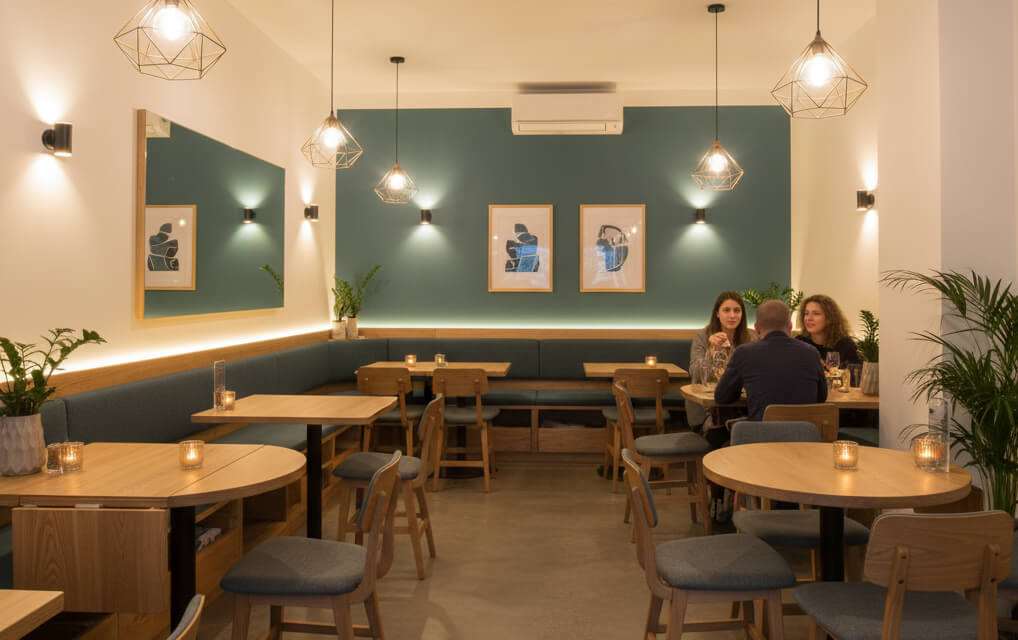October 10, 2025

A restaurant doesn’t need a large dining hall to make a big impression. With clever design, efficient layouts, and the right technology, small spaces can feel spacious, stylish, and profitable. Compact restaurant design is all about maximizing functionality while creating an inviting experience that keeps guests coming back. The key is in thoughtful planning and innovative use of available space.
Start by analyzing how customers move through your restaurant. From entry to exit, every corner should serve a purpose — whether it’s for seating, storage, or ambiance. This means maximizing functionality with furniture and design choices that don’t overwhelm the space but still meet your operational needs.
When it comes to space planning, restaurant layout software like Kitchen CUT or Smart Draw can help visualize the flow of your space and optimize seating arrangements (Kitchen CUT, SmartDraw).
In compact restaurants, digital tools can help you operate smarter. Technology not only saves physical space but also enhances operational efficiency and customer experience. By incorporating digital tools, you reduce the need for paper menus, paper reservations, or even physical waitlists.
Explore more essential tools to streamline your restaurant's operations in Restaurant Tech Stack: The 5 Tools Every Owner Needs. For advanced reservation management and more, check out OpenTable (OpenTable) or Resy (Resy) for efficient customer management systems.
A small restaurant’s reach shouldn’t stop at its walls. A well-designed website and strong online presence are crucial for attracting new customers. A great website not only helps people find your restaurant but also provides them with the information they need to make a decision: the menu, hours, reservations, and location.
Make sure your website is optimized for mobile users, as many customers will visit it from their phones. Additionally, ensure that your website is SEO-friendly so it shows up in local searches.
Building a large digital footprint:
See how to stand out online in How to Compete Against Chains with a Better Website and learn why not having a website can cost you in The Cost of Not Having a Website for Your Restaurant.
For website creation, platforms like RocketPages (RocketPages), Wix (Wix) or Squarespace (Squarespace) offer easy-to-use templates to get your restaurant’s website online quickly. WordPress with a restaurant theme can also provide a customizable option (WordPress).
Small restaurants thrive on personality and local connections. Hosting events or collaborating with nearby businesses can turn your small space into a community hub, helping to establish long-term relationships with your neighbors. Local partnerships can amplify your presence and attract foot traffic.
Learn more about how restaurants can benefit from community engagement in Why Restaurants Should Sponsor Local Events.
For creating event promotions, check out Eventbrite (Eventbrite) for easy event management, or Facebook Events (Facebook Events) for local event promotion.
Small restaurants need to create an atmosphere that feels spacious, welcoming, and memorable. Lighting, colors, and furnishings all play a significant role in creating a pleasant and visually engaging dining experience. Small spaces are perfect for experimenting with unique design elements that can leave a lasting impression on customers.
For sourcing stylish yet space-efficient furniture and décor, IKEA (IKEA) or Wayfair (Wayfair) offer great solutions for compact restaurant designs. You can also explore DesignCrowd for custom interior design ideas (DesignCrowd).
In conclusion, a small restaurant can make a big impact with the right design, technology, and community engagement. By optimizing space, embracing technology, building a strong online identity, fostering local connections, and carefully designing the ambiance, your small restaurant can offer an exceptional customer experience and become a local favorite. Don’t let limited square footage limit your potential — get creative, and maximize what you’ve got!
Stay up to date with the latest tips, expert insights, product reviews, and step-by-step guides to help you grow, create, and succeed—no matter your industry or passion.